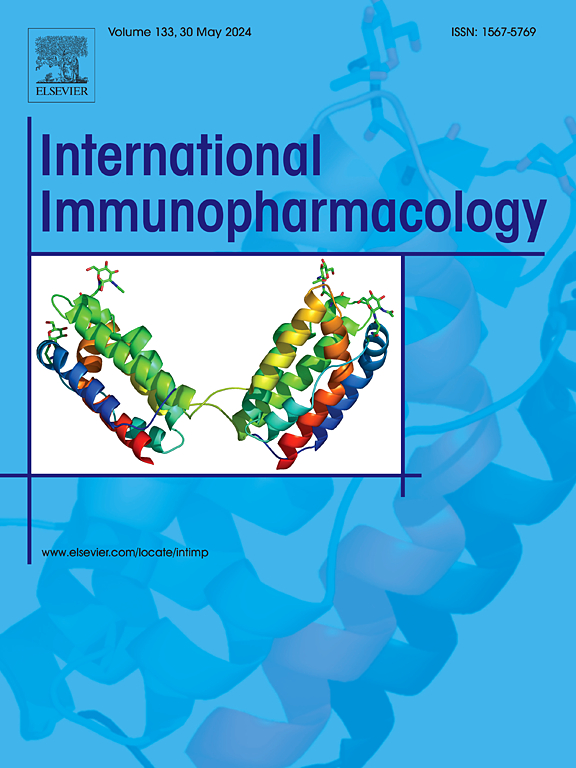基于孟德尔随机化和机器学习的三级淋巴结构相关基因特征与 HCC 的遗传关联及预后模型的构建。
IF 4.8
2区 医学
Q2 IMMUNOLOGY
引用次数: 0
摘要
背景:许多癌症类型都会形成三级淋巴结构(TLS)。然而,它们在肝细胞癌(HCC)中的价值和意义尚不清楚:我们基于癌症基因组图谱(TCGA)数据库对TLS相关基因(TLSG)进行了差异基因表达分析,并利用表达量性状位点进行了孟德尔随机化(MR)分析,然后提取了它们的交叉基因。利用最小绝对缩减和选择操作器(LASSO)、单变量和多变量COX回归分析构建了基于TLSG预后特征(TLSGPS)的风险评分,然后进行了生存分析。我们利用国际癌症基因组联盟进行外部验证。我们还基于TLSGPS进行了生物功能、肿瘤突变负荷、免疫浸润、单细胞分析、CeRNA和药物敏感性分析:结果:确定了三个TLSGs(HM13、CSTB、CDCA7L),构建了TLSGPS,其预测能力良好,优于大多数预后特征。MR表明,HM13(OR = 0.9997,95 %CI:0.9994-0.9999,P = 0.014)和CSTB(OR = 0.9997,95 %CI:0.9995-0.9999,P = 0.048)与HCC发病风险呈负相关,而CDCA7L(OR = 1.0004,1.0001-1.0007,P = 0.0161)则相反。基于TLSGPS的高危组(HRG)和低危组(LRG)之间的生物功能差异涉及细胞增殖、分化和药物代谢。HRG加上高突变表现出极低的存活率。结论:通过机器学习和磁共振鉴定出的3个TLSGs可以预测HCC患者的发病、预后和临床治疗,并与HCC有显著的遗传关联。本文章由计算机程序翻译,如有差异,请以英文原文为准。
Genetic association of tertiary lymphoid structure-related gene signatures with HCC based on Mendelian randomization and machine learning and construction of prognosis model
Background
Tertiary lymphoid structures (TLS) are formed in numerous cancer types. However, their value and significance in hepatocellular carcinoma (HCC) is unclear.
Methods
We performed differential genes expression analysis of TLS-related Genes (TLSG) based on The Cancer Genome Atlas (TCGA) database, and performed Mendelian randomization (MR) analysis using expression quantitative trait loci, and then took their intersecting genes. A TLSG prognostic signature (TLSGPS)-based risk score was constructed using Least Absolute Shrinkage and Selection Operator (LASSO), univariate and multivariate COX regression analysis, and survival analysis was then performed. We used the International Cancer Genome Consortium for outside validation. We also performed biological function, tumor mutational burden, immune infiltration, single-cell analysis, CeRNA and drug sensitivity analysis based on TLSGPS.
Results
Three TLSGs (HM13, CSTB, CDCA7L) were identified to construct the TLSGPS, which showed good predictive ability and outperformed most prognostic signatures. MR suggested that HM13 (OR = 0.9997, 95 %CI: 0.9994–0.9999, P = 0.014) and CSTB (OR = 0.9997, 95 %CI: 0.9995–0.9999, P = 0.048) were negatively correlated with the risk of HCC onset, while CDCA7L (OR = 1.0004, 1.0001–1.0007, P = 0.0161) was the opposite. The differences in biological functions between the TLSGPS-based high-risk group (HRG) and low-risk group (LRG) involved cell proliferation, differentiation, and drug metabolism. HRG plus high mutations exhibited extremely poor survival. HRG had higher abundance of immune cell-oncogenic phenotypes, higher immune escape ability, and greater sensitivity to Afatinib, Dasatinib, and Gefitinib.
Conclusion
3 TLSGs identified by machine learning and MR can predict the onset, prognosis and clinical treatment of HCC patients, and had significant genetic association with HCC.
求助全文
通过发布文献求助,成功后即可免费获取论文全文。
去求助
来源期刊
CiteScore
8.40
自引率
3.60%
发文量
935
审稿时长
53 days
期刊介绍:
International Immunopharmacology is the primary vehicle for the publication of original research papers pertinent to the overlapping areas of immunology, pharmacology, cytokine biology, immunotherapy, immunopathology and immunotoxicology. Review articles that encompass these subjects are also welcome.
The subject material appropriate for submission includes:
• Clinical studies employing immunotherapy of any type including the use of: bacterial and chemical agents; thymic hormones, interferon, lymphokines, etc., in transplantation and diseases such as cancer, immunodeficiency, chronic infection and allergic, inflammatory or autoimmune disorders.
• Studies on the mechanisms of action of these agents for specific parameters of immune competence as well as the overall clinical state.
• Pre-clinical animal studies and in vitro studies on mechanisms of action with immunopotentiators, immunomodulators, immunoadjuvants and other pharmacological agents active on cells participating in immune or allergic responses.
• Pharmacological compounds, microbial products and toxicological agents that affect the lymphoid system, and their mechanisms of action.
• Agents that activate genes or modify transcription and translation within the immune response.
• Substances activated, generated, or released through immunologic or related pathways that are pharmacologically active.
• Production, function and regulation of cytokines and their receptors.
• Classical pharmacological studies on the effects of chemokines and bioactive factors released during immunological reactions.

 求助内容:
求助内容: 应助结果提醒方式:
应助结果提醒方式:


